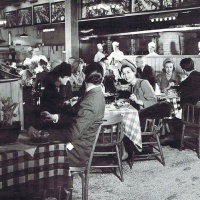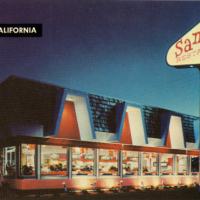Search for the words “restaurant row” in old newspapers before WWII and you will become convinced that a restaurant was a prime spot to be stabbed or clobbered by flying crockery. Not as dangerous as a barroom, but close.
The other meaning and pronunciation refer not to a fight but to a happier state of affairs, namely a street lined with restaurants that has become a popular destination for diners.
The earliest use of the term I’ve found is a 1909 reference to Chicago’s Randolph Street where 39 busy restaurants lined up on a six-block stretch [illustrated]. A bit later Chicago’s Wabash Ave. was known as cafeteria row, reportedly aggregating the largest number of self-service restaurants in the world, while Clark Street with all its lunch rooms was nicknamed “toothpick row.”
The reason restaurants group together is not hard to see. As was true for downtown department stores that occupied several corners of a single intersection, groups of the same kind of businesses attracted flocks of customers who knew they were likely to find something they wanted. In the early 20th century, when chain restaurants were becoming common, lesser known restaurants were eager to locate near the winners to catch their overflow.
It’s also a marketing ploy. City officials may declare a street Restaurant Row to help boost the local economy, as NYC mayor John Lindsay did in the depressed 1970s with West 46th Street between 8th and 9th. Actually New York had — and has — many restaurant rows, as is true of other large cities. Perhaps NYC’s first was Park Row in lower Manhattan where hungry politicians and newspaper workers crowded into Dolan’s, home of “beef an’” [corned beef and beans], which anchored the street’s concentration of lunch rooms.
 Los Angeles’ restaurant row on La Cienega Boulevard [illustrated at top] probably achieved more celebrity than did those of any other cities. Coming into prominence with the end of Prohibition in the 1930s it presented a mix of swanky restaurants and nightclubs alight with neon signs. In 1947 the row, centered at Wilshire and La Cienega, was enough of an attraction to inspire Southwest Airlines to offer a weekend jaunt built around it. One of the earliest restaurants in the row, Lawry’s The Prime Rib, established in 1938, continues today. Its owners also operated other La Cienega hotspots, Richlor’s [illustrated] and Steer’s.
Los Angeles’ restaurant row on La Cienega Boulevard [illustrated at top] probably achieved more celebrity than did those of any other cities. Coming into prominence with the end of Prohibition in the 1930s it presented a mix of swanky restaurants and nightclubs alight with neon signs. In 1947 the row, centered at Wilshire and La Cienega, was enough of an attraction to inspire Southwest Airlines to offer a weekend jaunt built around it. One of the earliest restaurants in the row, Lawry’s The Prime Rib, established in 1938, continues today. Its owners also operated other La Cienega hotspots, Richlor’s [illustrated] and Steer’s.
Although the 1960s and 1970s were decades of decline on Los Angeles’ restaurant row, it made a comeback in the 1980s and continues to attract visitors today.
 It didn’t take long for other cities, even small towns and suburbs, to realize that promoting a restaurant row was a way to bring people to town with money to spend. Restaurant rows with as few as four or five eating places began to advertise their attractions. [Route 9, Framingham MA illustrated]
It didn’t take long for other cities, even small towns and suburbs, to realize that promoting a restaurant row was a way to bring people to town with money to spend. Restaurant rows with as few as four or five eating places began to advertise their attractions. [Route 9, Framingham MA illustrated]
With the spread of fast food eateries in the 1960s, people began to refer to fast-food rows where pizza, fried chicken, and burger emporiums clustered together. Competing chains kept a close eye on where McDonald’s opened, figuring the fast-food leader had chosen well after conducting extensive research on demographics and traffic patterns.
© Jan Whitaker, 2015



















 If it weren’t for the steady number of souls searching the spheres for Nucleus Nuance, I’d hesitate to touch this subject. After all, it was a clubby hangout that I never experienced personally so I’m at risk of leaving out things that true-blue fans care about. On the other hand, there doesn’t seem to be much written about the restaurant side of this jazz nightclub, so here goes.
If it weren’t for the steady number of souls searching the spheres for Nucleus Nuance, I’d hesitate to touch this subject. After all, it was a clubby hangout that I never experienced personally so I’m at risk of leaving out things that true-blue fans care about. On the other hand, there doesn’t seem to be much written about the restaurant side of this jazz nightclub, so here goes.
 In 1979 Nucleus acquired new partners, the Venieros, who introduced fine vintage California wines, hooked up the restaurant with the Garlic Festival, and expanded the premises. Evidently, though, it remained unbeautiful. According to the Los Angeles Times in 1976, the dining room was windowless and “The front door leads you down a long corridor that makes you think you’ve walked in the back door by mistake.” In 1988 it sounded pretty much the same. A review by Alan Richman describes the entrance as “a nightmare, a series of twists and turns along a gloomy cinder-block passageway,” adding that the uninviting exterior was “white cinder-block, the front door solid black, the overhead awning worn out.” (He liked the place once he got settled.)
In 1979 Nucleus acquired new partners, the Venieros, who introduced fine vintage California wines, hooked up the restaurant with the Garlic Festival, and expanded the premises. Evidently, though, it remained unbeautiful. According to the Los Angeles Times in 1976, the dining room was windowless and “The front door leads you down a long corridor that makes you think you’ve walked in the back door by mistake.” In 1988 it sounded pretty much the same. A review by Alan Richman describes the entrance as “a nightmare, a series of twists and turns along a gloomy cinder-block passageway,” adding that the uninviting exterior was “white cinder-block, the front door solid black, the overhead awning worn out.” (He liked the place once he got settled.) Don Dickerman was obsessed with pirates. He took every opportunity to portray himself as one, beginning with a high school pirate band. As an art student in the teens he dressed in pirate garb for Greenwich Village costume balls. Throughout his life he collected antique pirate maps, cutlasses, blunderbuses, and cannon. His Greenwich Village nightclub restaurant, The Pirates’ Den, where colorfully outfitted servers staged mock battles for guests, became nationally known and made him a minor celebrity.
Don Dickerman was obsessed with pirates. He took every opportunity to portray himself as one, beginning with a high school pirate band. As an art student in the teens he dressed in pirate garb for Greenwich Village costume balls. Throughout his life he collected antique pirate maps, cutlasses, blunderbuses, and cannon. His Greenwich Village nightclub restaurant, The Pirates’ Den, where colorfully outfitted servers staged mock battles for guests, became nationally known and made him a minor celebrity.
 Over time he ran five clubs and restaurants in New York City. After failing to make a living as a toy designer and children’s book illustrator, he opened a tea room in the Village primarily as a place to display his hand-painted toys. It became popular, expanded, and around 1917 he transformed it into a make-believe pirates’ lair where guests entered through a dark, moldy basement. Its fame began to grow, particularly after 1921 when Douglas Fairbanks recreated its atmospheric interior for his movie The Nut. He also ran the Blue Horse (pictured), the Heigh-Ho (where Rudy Vallee got his start), Daffydill (financed by Vallee), and the County Fair.
Over time he ran five clubs and restaurants in New York City. After failing to make a living as a toy designer and children’s book illustrator, he opened a tea room in the Village primarily as a place to display his hand-painted toys. It became popular, expanded, and around 1917 he transformed it into a make-believe pirates’ lair where guests entered through a dark, moldy basement. Its fame began to grow, particularly after 1921 when Douglas Fairbanks recreated its atmospheric interior for his movie The Nut. He also ran the Blue Horse (pictured), the Heigh-Ho (where Rudy Vallee got his start), Daffydill (financed by Vallee), and the County Fair. On a Blue Horse menu of the 1920s Don’s mother is listed as manager. Among the dishes featured at this jazz club restaurant were Golden Buck, Chicken a la King, Tomato Wiggle, and Tomato Caprice. Drinks (non-alcoholic) included Pink Goat’s Delight and Blue Horse’s Neck. Ice cream specials also bore whimsical names such as Green Goose Island and Mr. Bogg’s Castle. At The Pirates’ Den a beefsteak dinner cost a hefty $1.25. Also on the menu were chicken salad, sandwiches, hot dogs, and an ice cream concoction called Bozo’s Delight. A critic in 1921 concluded that, based on the sky-high menu tariffs and the “punk food,” customers there really were at the mercy of genuine pirates.
On a Blue Horse menu of the 1920s Don’s mother is listed as manager. Among the dishes featured at this jazz club restaurant were Golden Buck, Chicken a la King, Tomato Wiggle, and Tomato Caprice. Drinks (non-alcoholic) included Pink Goat’s Delight and Blue Horse’s Neck. Ice cream specials also bore whimsical names such as Green Goose Island and Mr. Bogg’s Castle. At The Pirates’ Den a beefsteak dinner cost a hefty $1.25. Also on the menu were chicken salad, sandwiches, hot dogs, and an ice cream concoction called Bozo’s Delight. A critic in 1921 concluded that, based on the sky-high menu tariffs and the “punk food,” customers there really were at the mercy of genuine pirates.











 It's great to hear from readers and I take time to answer queries. I can't always find what you are looking for, but I do appreciate getting thank yous no matter what the outcome.
It's great to hear from readers and I take time to answer queries. I can't always find what you are looking for, but I do appreciate getting thank yous no matter what the outcome.


